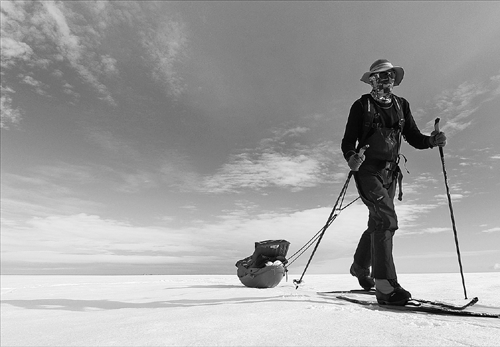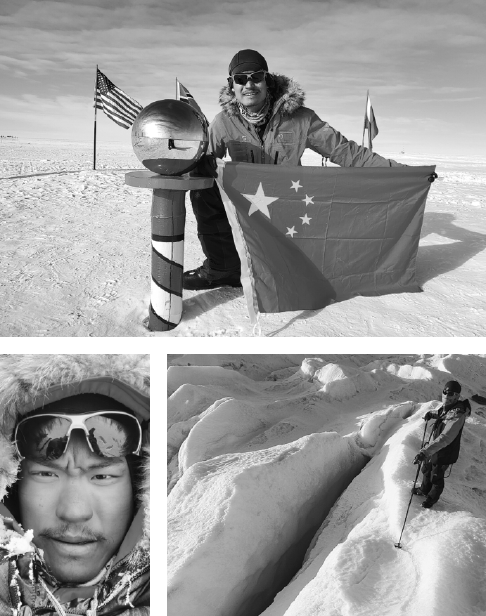JOURNEY TO THE SOUTH
A Chinese adventurer makes an arduous trip to raise public awareness of global warming, Li Yingxue reports.

The wind is strong at the South Pole, with a speed of over 20 kilometers per hour. When the sky turns milky white, a unique phenomenon in the polar regions, the horizon disappears.
With visibility less than a meter, and no object of reference in sight, dragging his 185-kilogram sledge, Wen Xu had to regularly consult his compass to ensure he didn't steer from his path and get lost in the seemingly endless white expanse.
On the second day of his adventure, in order to protect himself from the biting cold, he attempted to put on another down jacket, but to do so he had to remove his windproof gloves. Suddenly, a gust of wind caught the gloves, which disappeared into the alabaster emptiness. Worse still, as he attempted to recover them, his second warm layer, the jacket he was attempting to put on, also found itself carried off by the wind-a most unfortunate, and potentially dangerous, turn of events.
Wen was on his solo, unsupported, man-hauling ski trek across the Antarctic after setting off from the north shore of Berkner Island.
At the first opportunity, Wen contacted his wife, Hu Jiaojiao. Not, as you might imagine, assuaging her concerns about the risky endeavor he was undertaking, but because she was coordinating his expedition. Hu immediately contacted the polar logistics support and his consulting team in Norway. With two crucial items of cold-weather gear lost, Wen's team had to reevaluate the plan.
His journey continued. After wracking his brains, and days of thorough planning, Wen came up with a way of solving the problem-he had a backup sleeping bag that he turned into a down jacket, using dental floss to sew it.
On Jan 10, 2020, after skiing and man-hauling the sledge for 1,400 kilometers over 58 days, Wen finally reached the South Pole, becoming the first Chinese to make it to the landmark, physically on his own.
Earlier he had planned to cross the Antarctic, but Wen, 33, had to make the hard decision to abandon the final leg due to weather conditions and time constraints. Despite the disappointment, Wen, who studied geology from China University of Geosciences, says his main goal was to raise awareness, especially among Chinese youth, of global warming through his visit. He also wanted to collect samples to give for research, he says.
"I conquered difficulties on my solo trip to the South Pole," he says. "I hope it will bring more public attention to the issue of global warming."
'Three-pole challenge'
One summer, when he was 15 years old, Wen watched the Hollywood survival thriller Vertical Limit and fell in love with mountaineering and adventure. In 2002, while still in high school, he started physical training, including running, riding, swimming and hiking. He recalls he insisted on wearing just his slippers during harsh winters in his hometown of Tianjin in a bid to train his body to endure the cold.
Years later, in May 2017, high up on the Tibetan Plateau, Wen, an accomplished climber and adventurer by that time, fell through glacial ice and ended up submersed in icy water. The glacier had melted under the frozen surface due to a rise in the surrounding temperature. The experience awakened Wen to the dangers of global warming and pushed him to raise public awareness.
"If it hadn't been for my habit of swimming in winter, along with self-rescue training, I'd be dead after falling in the icy water," Wen says.
He recalls, between 2004 and 2018, over the course of 11 ascents of the 7,546-meter Muztagata, a mountain in the Xinjiang Uygur autonomous region, he had to change his huge ski board into crampons to contend with the rising snow line.
In 2018, Wen and Hu founded a Beijing-based nonprofit called Polar Hub, which aims to raise public awareness about the impact of climate change. They combine adventure and a scientific spirit, with Wen writing on social media about areas where climate change is most visible such as glaciers and ice caps.
Inspired by the 2015 Paris Agreement that stipulates the world should commit to capping the global temperature rise below 2 C, they started the <2° Project in 2018, to attempt a "three-pole challenge"-to reach both the North and South poles and climb Mount Qomolangma (known as Mount Everest in the West)-and do some research as well. The mountain is referred to as the third pole. That May, Wen reached the top of Mount Qomolangma, and in August, he took a 30-day trip of the Arctic via the North Pole. Both were in preparation for his trip to the South Pole.
Skiing great lengths
Wen got sponsors for his Antarctic adventure. They provided him with outdoor clothing, satellite communication and power source. Hu say the couple also spent over 2 million yuan ($306,000) of their own money on Wen's South Pole journey.
On Nov 13, 2019, Wen began skiing toward the pole. It was extremely difficult for him to haul his laden sledge on the snow and ice, but it was his lifeline. The sledge carried his scientific instruments along with all his gear, food and communication equipment. Each day he would consume about 1.5 kilograms of food, loading his body with some 6,000 calories needed to fuel his strenuous daily trudge. When he started, he weighed 85 kg, but by journey's end he was 65 kg.
Wen had a pretty strict daily schedule to follow-he would wake at 6:30 am to boil water and make breakfast so that he could be packed and ready to ski by 8 am. To conserve energy, Wen would divide his daily skiing into eight parts, resting for 10 minutes after every hour on the move. He would be asleep no later than 10 pm, something he found difficult as the distinction between day and night in the South Pole is no more than the sweeping of hands of a watch can determine.
Wen would draw a picture each night to record his mental condition. He could draw anything he wanted-he once drew a person crying, and another night, he drew a person falling in the snow. These were accompanied by daily vocal recordings. Sometimes, when he was happy, he would talk a lot, but when he was depressed, he only spoke a couple of words. The drawings and recordings will help scientists to analyze the mental and physical changes that occur in people under such extreme conditions, Wen says, adding that he hopes they will provide useful references for future endeavors to the southern continent.
A GPS device would relay his location to Hu every 10 minutes. Back in Beijing, the screen of Hu's computer would display Wen's direction, ski speed and the altitude he was at.
Each evening, Wen would use the satellite phone for about 5 minutes to report his progress to Hu, along with a summary of his physical and mental condition. They would then discuss the plan for the next day. Hu would shield him from anything that might distract him from his goal, especially online comments about his trip.
In the first 10 days, Wen only managed to ski about 70 km. A lot of the time, he was forced to wait for a break because of weather conditions. On the 11th day, the sun finally made an appearance and Wen was so happy that he sang as he skied. He covered 26 km that day alone, representing the longest daily distance he had traveled since starting out.
Each day he faced physical extremes. His sweat would form long icicles under his chin, making him resemble some kind of cartoonish Jack Frost. It didn't feel as funny as it looked, though. When he stopped skiing each day, he could barely stand upright. One day he hit such a low point that he cried out loud and yelled at the snow.
"Guess what? I couldn't hear my own yelling. The moment I opened my mouth, the wind blew the sound away," he recalls. "That's the South Pole."
He adds, "No matter how hard you thrash about, you won't make a wave. Even if I pray for its pity, it won't have any reaction."
Hu says she knew when her adventurer husband hit a wall, both physically and mentally. "I could tell he was depressed through the phone call. I worried about him but I tried to control my feelings when talking to him each day. If he wanted to blow off steam, I'd just listen."
On Jan 10 last year, Wen arrived at the pole in good shape, with no significant injuries or kit problems. However, Antarctic Logistics and Expeditions, provider of his air transport and logistical support, told him that, as they needed to pick him up on Jan 23, 2020, he had less than two weeks to cover about 600 km more if he wanted to continue skiing. That's when he stopped.
Wen plans to resume the journey someday. Meanwhile, Hu is keen to visit the South Pole herself. She says she hopes she can lead an allfemale team to Antarctica one day.
"People praise the fearlessness of adventurers. But in front of nature, we need to be careful," Wen says, warning about the climate crisis.



Today's Top News
- Xi urges studying, absorbing netizens' opinions in formulating 15th Five-Year Plan
- Yuan eyes greater role among safe-haven assets
- China set to clean up online health content
- China, EU can shape climate governance
- Chengdu gearing up for World Games
- Beijing, Kathmandu aim for new heights in relations






























